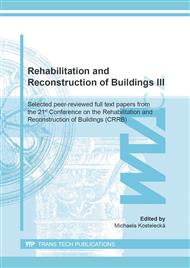[1]
Plastics Europe AISBL (2018). Plastics – the Facts 2018. An analysis of European plastics production, demand and waste data [PDF file]. https://www.plasticseurope.org/application/files/6315/4510/9658/Plastics_the_facts_2018_AF_web.
Google Scholar
[2]
Plastics Industry Association, History of Plastics [online]. Retrieved from: https://www.plasticsindustry.org/history-plastics. (Accessed: 19 October 2019).
Google Scholar
[3]
A. Lakshman, H. B. Devi and M. Dominic, Influence of Lightweight Aggregates on Various Properties of Concrete. Int. J. Eng. Res. Tech. 8 (2), (2019) 82-85.
Google Scholar
[4]
A.M. Hameed and B.A.-F. Ahmed, Employment the plastic waste to produce the light weight concrete. Energy Procedia 157 (2019) 30-38.
DOI: 10.1016/j.egypro.2018.11.160
Google Scholar
[5]
L. Gu and T. Ozbakkaloglu, Use of recycled plastics in concrete: A critical review. Waste Manage. 51 (2016) 19-42.
DOI: 10.1016/j.wasman.2016.03.005
Google Scholar
[6]
M. A. A. Aldahdooh, A. Jamrah, Ali Alnuaimi, M. I. Martini and A. S. R. Ahmed, Influence of various plastics-waste aggregates on properties of normal concrete. J. Build. Eng. 17 (2018) 13-22.
DOI: 10.1016/j.jobe.2018.01.014
Google Scholar
[7]
M. Vaiciene, J. Malaiskiene and O. Kizinievic, Possibilities of Plastic Waste Application in Expanded Clay Concrete. IOP Conf. Ser.: Mater. Sci. Eng. 471 (2019) 032009.
DOI: 10.1088/1757-899x/471/3/032009
Google Scholar
[8]
W. Zhang, Y. Lyu and P.Liu, Review on the Research Progress of EPS Concrete. Materials Reports 33 (13), (2019) 2214-2228.
Google Scholar
[9]
N. Liu and B. Chen, Experimental study of the influence of EPS particle size on the mechanical properties of EPS lightweight concrete, Constr. Build. Mater. 68 (2014) 227-232.
DOI: 10.1016/j.conbuildmat.2014.06.062
Google Scholar
[10]
A. A. Sayadi, J. V. Tapia, T. R. Neitzert and G. C. Clifton. Effects of expanded polystyrene (EPS) particles on fire resistance, thermal conductivity and compressive strength of foamed concrete, Constr. Build. Mater. 112 (2016) 716-724.
DOI: 10.1016/j.conbuildmat.2016.02.218
Google Scholar
[11]
R. Wang and C. Meyer, Performance of cement mortar made with recycled high impact polystyrene, Cement Concrete Comp. 34 (9), (2012) 975-981.
DOI: 10.1016/j.cemconcomp.2012.06.014
Google Scholar
[12]
K. Kapoor, B. K. Gupta and S. Singh, Properties of Concrete Made with Plastic Aggregates. In: Agnihotri A., Reddy K., Bansal A. (eds) Sustainable Engineering. Lecture Notes in Civil Engineering, Vol 30. Springer, Singapore (2019) pp.349-358.
DOI: 10.1007/978-981-13-6717-5_34
Google Scholar
[13]
N. Saikia N J. de Brito: Waste polyethylene terephthalate as an aggregate in concrete. Mater. Res. 16 (2), (2013) 341-350.
DOI: 10.1590/s1516-14392013005000017
Google Scholar
[14]
M. Frigione, Recycling of PET bottles as fine aggregate in concrete, Waste Manage. 30 (6) (2010) 1101-1106.
DOI: 10.1016/j.wasman.2010.01.030
Google Scholar
[15]
K. Sugunadevi, Jayshree Natchiyar, J. Dhivya and A.S. Arshavardhini, Experimental Research on the Behaviour of Concrete Containing Waste Plastic Granules as a Fine Aggregate Replacement. In: International Journal of Innovative Technology and Exploring Engineering (IJITEE) Vol. 8 (10), (2019) pp.1427-1430.
DOI: 10.35940/ijitee.a1009.0881019
Google Scholar
[16]
D. Rumšys, D. Bačinskas, E. Spudulis and A. Meškėnas, Comparison of material properties of lightweight concrete with recycled polyethylene and expanded clay aggregates, Procedia Eng. 172 (2017) 937 – 944.
DOI: 10.1016/j.proeng.2017.02.105
Google Scholar
[17]
E.A. Ohemeng and S. O. Ekolu, Strength prediction model for cement mortar made with waste LDPE plastic as fine aggregate, J. Sustainable Cem.-Based Mater. 8 (4), (2019) 228-243.
DOI: 10.1080/21650373.2019.1625826
Google Scholar
[18]
R. O. Machado, L. C. K. M. Pereira, E. B. Zanelato, A. L. F. Manhães,A. R. G. Azevedo, M. T. Marvila, J. Alexandre, S. N. Monteiro and L. T. Petrucci, Incorporation of EVA Residue for Production of Lightweight Concrete. In: Characterization of Minerals, Metals and Materials 2019. Springer, Switzerland (2019) pp.673-681.
DOI: 10.1007/978-3-030-05749-7_67
Google Scholar
[19]
STN EN 197-1 2012 Cement Part 1 Composition, specifications and conformity criteria for common cements.
Google Scholar
[20]
L. Svoboda et. all., Building Materials, second ed., Jaga Group s.r.o., Praha, (2007).
Google Scholar


